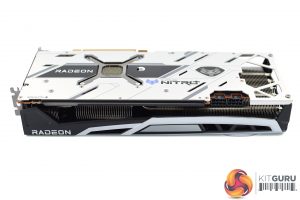The Sapphire RX 6800 XT Nitro+ ships in a dark blue box, with the Nitro logo visible in a neon blue colour on the front.
On the back, several specifications of the GPU are listed, while Sapphire also highlights some of the design features of the Nitro+ card.
Not much is included in the way of accessories, with just a quick installation guide and manufacturer note in the box.
As for the graphics card itself, its design language is overall fairly similar to the RX 5700 XT Nitro+ that we reviewed in 2019. It's a mostly black plastic shroud, but with some prominent silver sections as well which add some contrast to the design.
Looking at the fans, here we can see some tweaks to the design. First of all, there’s two 100mm fans at either end, while the central fan is slightly smaller at 90mm. All three feature a new ring around the outer edge of the fan, and Sapphire calls the new design a ‘Hybrid Fan', as they say it is meant to offer the increased pressure of a blower fan combined with the traditional low noise levels of an axial fan. We can also see the central fan spins in reverse, relative to the outer two, similar to what we’ve seen from the likes of Gigabyte and ASUS over the past year or two.
In terms of its size, the Nitro+ measures 310 x 134.3 x 55.3mm, so it is fractionally smaller than the PowerColor Red Devil (which is 320 x 135 x 62mm), but not by a lot. Sapphire is keen to emphasise the lower weight of the Nitro+ though, and on my scale it weighs in at 1239g. The Red Devil is almost 400g heavier at 1612g, while the reference design weighs in at 1496g.
On the front edge of the card, we get a look at the dual BIOS switch. By default, the Nitro+ uses the Performance BIOS (number 1), but you can switch it over to the Silent BIOS (number 2) as well, which drops fan speed, clocks and the power target. There’s even a third position on the BIOS switch, but this is to let you change between Performance and Silent modes using the Trixx software.
In terms of the backplate, this is a full length aluminium design with a pretty striking silver colour, and I have to say I do really like the aesthetic. There’s a cut-out behind the GPU die, and also at the very end of the card to provide a bit of flow-through from the fan. We can also note the Nitro logo is one of the RGB zones on the card. The rest of the RGB comes from a strip running along the front edge, as well a small Sapphire logo on the front as well. There’s even an ARGB header at the end card to synchronise the lighting with your motherboard.
Elsewhere, we can note the two 8-pin power connectors, while the display outputs consist of 1x HDMI 2.1, and 3x DisplayPort 1.4 connectors.
Dissembling the card, the first thing to touch on is the use of a dedicated heatsink for the memory and VRM. This uses a couple of flattened heatpipes and three small fin stacks, contacting with the memory and VRM via thermal pads. The primary heatsink also sports three, much larger fin stacks, connected by 6x 6mm heatpipes. Meanwhile, the GPU die contacts with a copper baseplate.
As for the PCB, this looks pretty similar to AMD's reference design, with a 13-phase VRM for the GPU and 3-phase VRM for the memory. Sapphire is using International Rectifier TDA21472 MOSFETs, rated at 70 Amps, while the GPU VRM controller is the Infineon XDPE132G5D. The memory controller is an International Rectifier IR35217, while we can also note the memory modules themselves are from Samsung, rated for 16Gbps.
Finally, the backplate uses one small thermal pad to contact the underside of the PCB.
 KitGuru KitGuru.net – Tech News | Hardware News | Hardware Reviews | IOS | Mobile | Gaming | Graphics Cards
KitGuru KitGuru.net – Tech News | Hardware News | Hardware Reviews | IOS | Mobile | Gaming | Graphics Cards






















